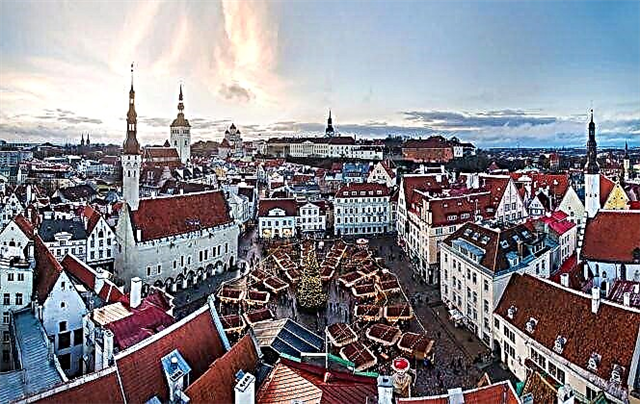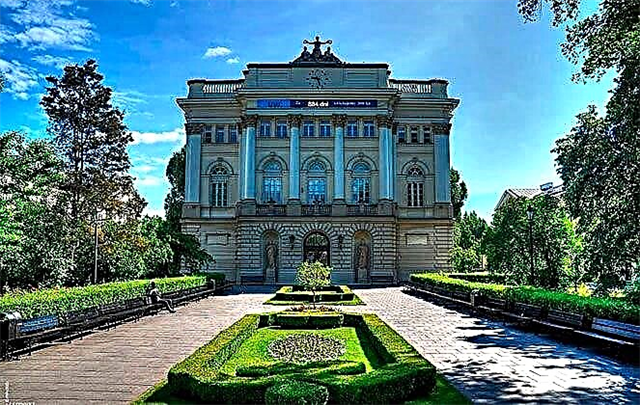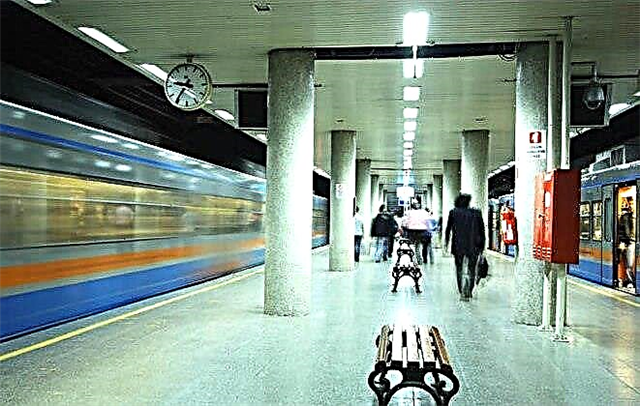The church in the small German city of Ulm is considered the tallest in the world. It rises 161 meters above the city and was built over five centuries. Initially, the builders did not plan to set a world record, it happened by accident. Despite the fact that the church did not have a bishop's residence, due to its impressive size, it was awarded the title of cathedral. Ulm Cathedral is considered an architectural masterpiece and attracts thousands of tourists every year.

Cathedral characteristics
The cathedral is Lutheran and can accommodate about twenty-five thousand people, excluding seating. The cathedral is 123 meters long and 49 meters wide. The structure cannot be called monolithic: it consists of three naves, central and side.
The main part of the building is the highest, the side structures are much lower. Inside you can find various sculptures, among them the statue of Christ, created in the 15th century.
Ulm Cathedral combines the best features of the Gothic trend in architecture and the work of more than one generation of builders.
During World War II, the church was not damaged, while the rest of the city was almost completely in ruins. Rumor has it that Churchill himself forbade the cathedral to bomb.
The cathedral is located in the very center of the city on Münsterplatz, as part of a modern tourist complex and is open all year round.
Construction and restoration
The construction of the Ulm Church was associated with the desire of local residents to acquire a working church inside the city walls. It so happened that the only accessible temple was outside the defensive structures and it was impossible to get to it during the siege. Attacks at that time were not uncommon for the city, and Germany itself often became a theater of war. For example, in 1377 Ulm was besieged by the emperor of the Roman Empire Charles IV.
During the first stage of construction, residents collected money on their own. Despite the fact that only 10 thousand people lived in Ulm, the required amount was found quite quickly, and the laying took place in 1377.
The project turned out to be ambitious, so it was decided to divide it into two stages. The first architect was Heinrich Parler, he planned to build a church with two naves and several towers. But due to constant delays and a lack of funding, he was able to finish only the lower part of the structure.
The statistics for 150 years of construction are amazing: the project had 6 new architects, some did not want to take on a difficult project, others were dying of old age. Each architect brought his own into the initial project - this is how a third nave and a high tower appeared, which was planned to be taken under the bell tower.
Another crisis period for the temple came in the New Time - the religious wars that broke out in Germany slowed down the construction. The number of dissatisfied with the Catholic Church grew. Theologian Martin Luther headed one of these movements, and the Protestant movement was later named after him.
Until the middle of the 17th century, Germany experienced several bloody conflicts, including the Thirty Years' War, which lasted from 1618 to 1648.
The tense situation and already traditional money problems led to the fact that in the middle of the 19th century, Ulm Cathedral was still unfinished.
At that time, the height of the main tower exceeded 100 meters, and the architects began to strengthen the supporting structures. The side aisles were not designed for such a load and could simply collapse at any moment.
In 1840, the second and final stage of construction began. The construction of the Western Tower took ten years, and the cross on the highest spire was installed only in 1890. The ceremony became a landmark, it marked the completion of the long-term construction of the temple. The holiday became national, at that time Germany was already united around Prussia.
Since 2021, the cathedral will be reconstructed, there are problems with the stone foundation. However, construction work does not prevent him from working and receiving tourists. If the main entrance to the central hall is closed, visitors enter through two side ones.
Exterior and interior
The cathedral was built in the Gothic style - gray, with sharp outlines and chimeras that stand out against the background of the city. Lancet lines predominate on upwardly elongated buildings. The windows are elongated, the structures are openwork with an emphasized skeleton.
Massive vaults, high spiers, battlements - Ulm Cathedral has collected the main features of the Gothic, it is often called a living encyclopedia of this architectural trend. Despite the fact that in the nineteenth century in Western Europe Gothic was not in vogue, the original project did not change. This helped the church become even more exceptional.
Inside the cathedral, as a rule, it is rather dark and quiet, the room is lit by parishioners' candles. The confessional are used for their intended purpose, so they are closed for tourists. The walls are decorated with frescoes and mosaics. The painted ceiling is supported by tall massive columns that run the entire length of the building.
Above the central entrance, opposite the altar, there is an organ. The benches are decorated with carved figures. Wooden busts of biblical characters, made by Jörg Sirlin in the altar, gained worldwide fame and became a model of late Gothic sculpture.
The high spiers can be climbed by the old steps. There are 768 of them and they lead to the equipped observation deck.
Excursion to Ulm Cathedral
Ulm Cathedral is located in the heart of the city at 21 Münsterplatz, Ulm, Baden-Württemberg. Nearby, by the way, is the old town hall and another church intended for citizens of Orthodoxy.
The opening hours of the temple vary depending on the season. In summer it is open from 9.00 to 19.00, in winter from 9.00 to 17.00. As a rule, tourists are asked to leave the premises at 18:45 or 16:45. The ascent to the observation deck at any time of the year is closed one hour before the end of the cathedral's work.
This masterpiece of Gothic architecture is so huge that it undergoes almost constant restorations and renovations. For this reason, the entrance to some parts of the building is sometimes closed to tourists.
The entrance to the temple itself is free. Anyone can make a donation, for which the church in Ulm functions. It is allowed to take photos inside, but it is not accepted to talk loudly.
The ascent to the observation deck is paid, tickets are purchased automatically through a ticket machine with a turnstile, they cost 5 euros per person.
A tourist can visit Ulm Cathedral both independently and as part of a group. City walks offered by the guides cost between € 100 and € 150.
In addition to the cathedral, Ulm has a lot to see. The old fishing quarter is filled with half-timbered houses, the Ulm Library, the so-called glass pyramid, as well as the old town hall, which we mentioned above, dated 1370, will interest tourists.
A whole complex of buildings of the XV-XVI centuries has been preserved separately. In the suburbs, there is the Bread Museum, a gallery of modern art, and a late Baroque church.
How to get to the city and the cathedral
From another country, the most convenient way to get to Ulm is via Stuttgart or Munich. The city is located at a distance of 90 and 140 kilometers from the airports of these settlements, respectively.
After the plane has landed in Stuttgart, we advise you to go to Ulm by train. The trip will take only one hour and cost 35-45 euros.
Trains on this route leave Stuttgart every half hour, starting at 3:30 am until midnight. Buses run every hour on the A8 highway.
Taxis are the most expensive.Trains also run from Munich to Ulm, the travel time is 1.5 hours, the ticket price is from 45 euros.

Ulm itself is small, so tourists prefer to walk around it. There is an opportunity to travel by bus or to explore the city on boats plying along the Danube.
For cycling enthusiasts, there is a bike rental service. It is located between the train station and the bus station on Friedrich-Ebert-Straße.
The historic city center is located on the right bank of the Danube.
Ulm churches
In addition to the most famous temple, there are other buildings in Ulm that are no less beautiful and valuable from an architectural point of view.
- For example, the Catholic Church of St. George. It was erected at the beginning of the 19th century and has remained practically unchanged since that time. It was built of red brick and limestone in the late Gothic style.
- The Protestant parish was built in 1908 and is a concrete Art Nouveau building. The observation towers rise 50 meters.
- St. Valentine's Orthodox Chapel is located very close to Ulm Cathedral. It appeared in the 15th century, since then it has been used both as a warehouse and as a bomb shelter during the war. Today it belongs to the Berlin Diocese of the Moscow Patriarchate.
- The Church of St. John the Baptist delights many with its appearance. It was built in the style of expressionism, at first glance it is simple and even stingy with the interior decoration. But he begins to play with new colors when the sun's rays peep into the windows of the building.
Outcomes
Germany is a rich country not only in castles, but also in ancient temples, which are distinguished by sophisticated architecture - Aachen, Berlin Cathedral, the Church of St. Elizabeth.
Ulm Cathedral, on the other hand, is a world-famous historical and architectural monument (not only in Germany) with a record height of 161 meters. The church was built over five centuries, and today it is regularly reconstructed. Tourists are attracted by both the external and internal decoration of the cathedral, as well as the opportunity to climb to the observation deck, which allows them to see the whole city.
By the way, being in Munich, be sure to visit the Church of St. Peter.











